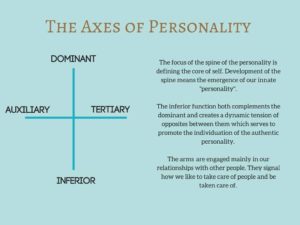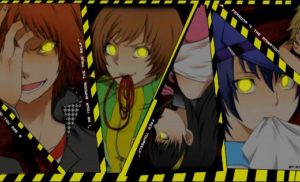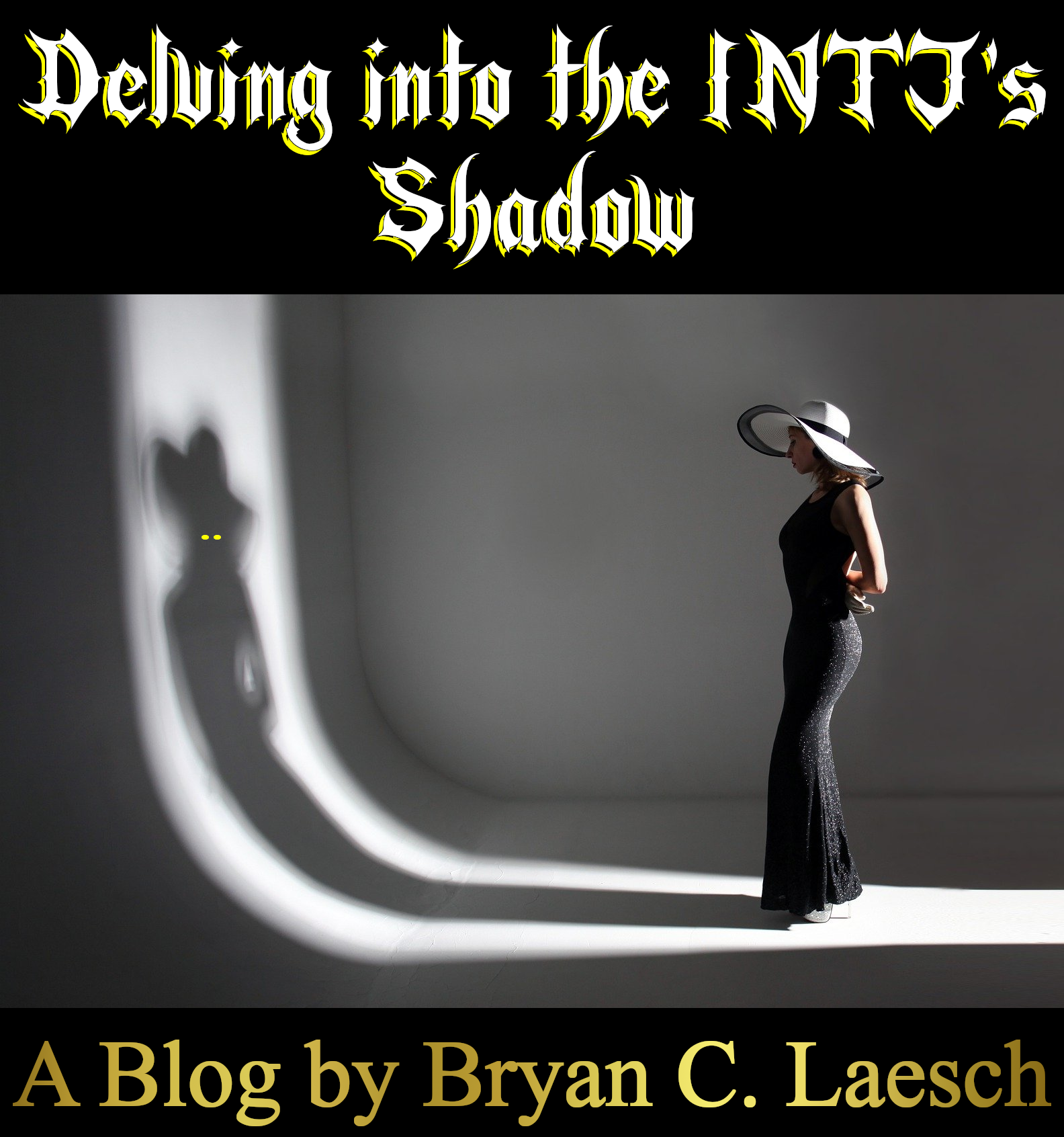Good news, everyone!
MBTI is a very complicated topic. Back in 2015 when I first got my job writing articles for 16Personalities, I was pretty cocky and thought learning about MBTI would be a breeze. And to an extent, it was…for 16P. But I had no idea what sort of rabbit hole I would fall down and the sorts of things I would discover. At one point, I was all about the preferences and thought that cognitive functions and function stacks were—and I quote myself—“crapola”. The reason I thought that was for no more reason other than I thought it was too complicated, when in actual fact, I didn’t know the first thing about it. Skip ahead a couple years and a few books and blog entries later, and now I quite like the cognitive functions, although I will admit that some of my understanding is still lacking.
Anyway, anyone who is familiar with the function stack and the four cognitive functions that make up a personality will likely have seen 8-function function stacks along with terms like Hero, Parent, Child, Animus, Villain, Critic, Trickster, Demon, and even Ego and Shadow. This was new to me as well, and instead of denigrating it like I did to the functions, I decided to learn about this system, hoping to learn something about myself in the process. Here’s what I discovered.
Different Selves of the Personality
In order to understand the 8-function function stack, it is important to know that personality can be broken up into three different selves: the Ego, the Persona, and the Shadow. The two main selves are the Ego and the Shadow; I’ll cover the Persona when I cover the Animus. For now, let’s cover the Ego.
The Ego
The Ego is defined as the conscious self. It is the one that interacts most with the world and is consciously available to a person. It is also what we imagine ourselves to be—our conceived identity. The usual 4-function stack is the Ego stack. But before I go over that, I must first address the “Axes of Personality” theory.
 What this theory attempts to do is visualize the dimension of personality as two intersecting lines known as the “spine”, which is the Y-axis, and the “arms”, which are the X-axis. The spine is composed of the Dominant and Inferior functions, and defines the “Core of Self”. Development of these two functions leads to the emergence of our innate personality. This is done by our Inferior function complementing and creating dynamic tension by opposing our Dominant function. This serves to promote the individuation of authentic personality. The arms meanwhile are made of the Auxiliary and Tertiary functions, which are responsible for how we handle our relationships. The Auxiliary function signals how we take care of or relate to others, and the Tertiary function signals how we like to be taken care of or how we want others to relate to us. So, what does this all mean for INTJs?
What this theory attempts to do is visualize the dimension of personality as two intersecting lines known as the “spine”, which is the Y-axis, and the “arms”, which are the X-axis. The spine is composed of the Dominant and Inferior functions, and defines the “Core of Self”. Development of these two functions leads to the emergence of our innate personality. This is done by our Inferior function complementing and creating dynamic tension by opposing our Dominant function. This serves to promote the individuation of authentic personality. The arms meanwhile are made of the Auxiliary and Tertiary functions, which are responsible for how we handle our relationships. The Auxiliary function signals how we take care of or relate to others, and the Tertiary function signals how we like to be taken care of or how we want others to relate to us. So, what does this all mean for INTJs?
I’ll get more into it when I go over the function roles of the Ego, but to begin with, we must first know what the four Ego functions of the INTJ are. They are Ni (introverted intuition), Te (extraverted thinking), Fi (introverted feeling), and Se (extraverted sensing). Ni and Se make up an INTJ’s spine, while Te and Fi make up the arms. What does this mean for an INTJ’s personality?
Well, with Ni and Se complementing and torquing on one another, this is why INTJs possess a mind-body connect or disconnect, struggle between the dichotomy of ideals and reality, and struggle to forge the perfect. With Te and Fi meanwhile, INTJs reach out to the world with Te, using reason to deal with others (hence why we come off as cold), but by wishing to be treated according to Fi, we want others to validate our most authentic ourselves, preferably by being authentic themselves. Or so, that’s how the theory goes.
Functions’ Roles of the Ego
Now, let’s talk about the Ego.
When it comes to typology, many typologists rely on archetypical roles and symbolism as a shortcut to help understand certain phenomenon. And this is how the four functions’ roles within the Ego, and the Shadow, are understood. This is where terms like Hero and Demon come from. So, let’s take a look at the roles of the Ego and how they relate to the INTJ 4-function stack.
The Hero (Dominant Function)
The Dominant function is the Hero. It is simply defined as the superior function. It is easy to develop, and the one we have the most conscious control over. It is at the very center of the Ego, and it should be detectable when a person gives off a sort of “take charge” energy. That’s all well and good, but what does that really mean for Ni?
That’s somewhat difficult to nail down for Ni as it is a perceiving function and the most introverted of all the functions. But, if it were to move proactively, it would sort through everything it new and had experienced, trying to connect dots where possible and come to a final conclusion, sort of like a detective. And it being the “core” of the Ego—the perceived or conscious self—that would mean that Ni is what gives INTJs their otherworldly aura. It’s why they seem disconnected from the world (because they are, preferring more to focus internally) and why they’re so obsessed with the truth, insight, and the deeper meaning behind people, occurrences, and objects.
The Parent (Auxiliary Function)
The Auxiliary function is the Parent. It’s meant to support the Dominant function, and it’s shown when we take care of and nurture others and ourselves. It is recognized when one gives off a supportive, nurturing, positive-enabling, or protective manner.
The issue with that, however, is that some people wouldn’t label INTJs as nurturing or positive-enabling. And it doesn’t help much that a part of the Parent’s function is to take care of ourselves, and with that being left to Te, it’s no wonder INTJs can come off as cold, exclusive, and self-centered—they’re merely applying logic as a means of taking care of themselves. This is also where INTJs get the reputation for disliking feelings and wanting to fix problems or complaints as they come up. This is the source of their desire to see efficiency demonstrated in the outside world and sense demonstrated among people.
However, I think it would be a great disservice to say that Te can’t be used in traditionally nurturing ways. How can Te being used as such? Well, think of when someone says “I can’t do it”. Many people’s first inclination is to commiserate with the person and offer them emotional support. Not the INTJ. An INTJ will instead reply with “Why not?” or “What’s the problem?” The INTJ does this as a means of helping someone try to rationalize away their self-doubt. Rather than being emotionally supportive, the INTJ helps a person overcome their self-doubt by seeing that they can do it or by helping them figure out their problem.
 An example of this can be seen in my own life from back when I was a tutor. When my students were having trouble getting the hang of the subject matter, instead of saying “poor thing” or “I’m sorry”, I pursued avenues that enabled them to overcome their problems. I showed them every way I could to help them learn the material and then I’d drill the method into them with practice, practice, practice. I didn’t empower them—I showed them how to empower themselves. As the saying goes, “give a man a fish, and he’ll eat for a day; but teach a man how to fish, and he’ll eat for the rest of his life”.
An example of this can be seen in my own life from back when I was a tutor. When my students were having trouble getting the hang of the subject matter, instead of saying “poor thing” or “I’m sorry”, I pursued avenues that enabled them to overcome their problems. I showed them every way I could to help them learn the material and then I’d drill the method into them with practice, practice, practice. I didn’t empower them—I showed them how to empower themselves. As the saying goes, “give a man a fish, and he’ll eat for a day; but teach a man how to fish, and he’ll eat for the rest of his life”.
The Child (Tertiary Function)
The Tertiary function is known as the Child. It is often referred to as the “relief” function because it is used to relax and take pressure off the Dominant and Auxiliary functions. It helps indicate the ways we want to be comforted, and it can also be wielded in playful, exploratory, or creative ways. However, it can manifest in manic ways, going from being on top of the world one minute to being injured and frightened the next. Good integration of the Child could mean allowing ourselves to be playful, silly, irresponsible, and vulnerable when appropriate or healthy to do so.
But here’s the problem with all that—I don’t think of Fi as being a playful or relaxing function. It runs in the same vein as Ni and Te—it’s very intense. It has a specific goal and methodology. Perhaps this helps to explain why some INTJs are so high-strung—because three of our four Ego functions are so strong.
However, I think I can see what they mean by the Child helping to take pressure off the Dominant and Auxiliary functions. As already stated, Ni is constantly looking for an answer to everything, while Te is there to rationalize everything. Running on these two functions must be exhausting because they don’t give a moment’s rest. They also help to separate an INTJ from everyone else. But with the utilization of Fi, not only can INTJs allow themselves a chance to escape their minds and feel how they’re doing, it also helps them reach out to others that they see struggling, especially if the others are victims of an unjust system. Fi also helps to make sure that an INTJ doesn’t lose himself to cold rationale and possibly committing evil acts simply because they are efficient. Fi is what keeps INTJs human. It’s what prevents them from becoming Lovecraftian-inspired monsters and robots.
As for how it helps to indicate how we want to be taken care of, it simply wants to make sure that we are validated as individuals. There’s a reason INTJs hate generality. We want to be seen and appreciated for who and what we are just as much as anybody else, but because Ni and Te get in the way, or because that’s all we show, many seem to forget that we’re capable of feeling and valuing ourselves. It’s also nice to be recognized for being good, moral, or just, which is often times hard to display because our morality is one of reason rather than feeling. But we want to be known for being moral just as much as we want to be known for being intelligent or wise. In fact, many of us would argue that intelligent and moral are not mutually exclusive—you can’t be one without the other.
As for using Fi for play, this one was originally quite difficult for me to solve. How does one use Fi to play? I suddenly realized it while I was writing my blog for what INTJs consider to be deep conversations. What I realized is that Fi is at play when it considers what-ifs and moral quandaries, especially because those things can offer insight into who a person is at their core.
And lastly, Fi being manic. This is another one that’s a little difficult to grasp. The only example I can think of is that Fi is on top of the world when INTJs use it to act as great equalizers and arbiters of justice. Fi is what allows us to feel like a superhero, and who doesn’t want to be a superhero? As for injured and frightened, I believe those feelings manifest when INTJs catch themselves doing something hypocritical. Fi is what keeps us on the straight and narrow, even if our morality is one we made up ourselves. Fi is there to prevent us from wandering, and so when we do something lazy or malicious, we feel like garbage about it for a long, long time.
The Animus (Inferior Function)
And last of the Ego functions, the Inferior function is the Animus. It is the least conscious of the Ego functions, and is therefore the doorway to the unconscious/Shadow functions. And since it is the opposite of the Hero function, it is often suppressed, resulting in the creation of the Persona, which is a version of the self that hides or denies the Inferior function. It is often hidden due to our inability to wield it effectively, although we are often envious of those who can. And, in order to properly develop the Hero, the Animus must be developed as well, lest we run the risk of becoming one-sided, imbalanced, or unhealthy.
The great shame of the Animus is that it’s not really defined. It’s merely stressed that it’s important to develop it. And when properly developed, it allows for development of the Shadow functions. So, what can we say about the Animus in relation to INTJs?
 Well, the immediately obvious thing to note is that when the Animus is neglected, a Persona appears, and since the Inferior function of INTJs is Se, this would mean that the stereotypical INTJ, the one that doesn’t do things like dance, eat, or enjoy life in the moment, is actually a Persona—it’s a fake. That’s right—the stereotypical INTJ is a fraud! While I admit that I quite enjoy spending most of my time in the world of the cerebral, I can’t simply brush off the world or anything that is aesthetically pleasing. I enjoy being active and pushing the limits of my physical body. I enjoy the touch and sensation of things, like the cold, hard blade of a knife, or the soft, warm furry coat of a dog. And I enjoy looking at things that are pleasing to the eye, whether they’re the fine, developed curves of a supercar or a beautiful woman. And speaking of women, I have just as much of a desire to touch intimately as to be touched intimately. Seriously, only a liar says he doesn’t like hugs.
Well, the immediately obvious thing to note is that when the Animus is neglected, a Persona appears, and since the Inferior function of INTJs is Se, this would mean that the stereotypical INTJ, the one that doesn’t do things like dance, eat, or enjoy life in the moment, is actually a Persona—it’s a fake. That’s right—the stereotypical INTJ is a fraud! While I admit that I quite enjoy spending most of my time in the world of the cerebral, I can’t simply brush off the world or anything that is aesthetically pleasing. I enjoy being active and pushing the limits of my physical body. I enjoy the touch and sensation of things, like the cold, hard blade of a knife, or the soft, warm furry coat of a dog. And I enjoy looking at things that are pleasing to the eye, whether they’re the fine, developed curves of a supercar or a beautiful woman. And speaking of women, I have just as much of a desire to touch intimately as to be touched intimately. Seriously, only a liar says he doesn’t like hugs.
As for how INTJs admire those who wield Se effectively, there is a definite sense of envy for those who can completely let go and enjoy themselves. People who can let themselves dance when the music hits them right, or just actually enjoy a moment. I find that I have a difficult time of letting go and turning off my analytical mind or reserved attitude while I’m out with friends. It’s just not something I can do. Further, I would say that I do find Se-dominant personalities attractive. Something about a girl greatly enjoying herself and being the center of attention does make me wish I could be with her.
As for how Se balances out Ni, this concept is a little harder to grasp. On the surface it only seems to indicate what happens to INTJs who don’t develop their Se, but I want to say there’s more to it than that. I want to believe that a healthy understanding of the outside world can aid an understanding of the deeper world. Somehow the answer to the unseen and untouched can only be found in the world of what is seen and touched. And indeed, if we expect to find an answer to everything, we must have some knowledge of everything. How can we expect to find the answer that connects it all when we don’t know it all? Without knowledge of the physical world, there are holes in our knowledge and therefore a hole in our conclusion. Ergo, Ni needs Se to fill in the gaps.
The Shadow
 So, with the delving into the Ego complete, it is now time to look at the Shadow.
So, with the delving into the Ego complete, it is now time to look at the Shadow.
Where the Ego is the present or conscious self, the Shadow is the hidden or unconscious self. It is also sometimes referred to as the dark, unlived, and repressed side of the self. Here, we may also find what we deem as uncouth, which includes those functions that are not found in our Ego stack.
The Shadow can be both good and evil. On the one hand, it lies in opposition to the Ego, and can hide uncomfortable truths about us that we try to discard. After all, the Ego is crafted from carefully selected qualities, while the unwanted ones are discarded into the unconscious. And the reason we may view the Shadow functions as negative is because we may not have conscious control over them. When we are impacted by them, we tend to behave in irrational, unreasonable, or even morally ambiguous ways. They can be highly destructive in this manner. We can also project the negative aspects of the Shadow functions onto others.
Despite all that, though, the Shadow can do a great amount of good. The Shadow can come and go out of consciousness as a way of protecting the Ego when it’s not doing a good enough job on its own. The main goal of the Shadow functions is to stabilize us and prevent ego inflation and disruption of the Ego from threats to our integrity. It both protects and limits, but when the Shadow is defending the personality, it will fight dirty if it needs to. It helps us in those times of extreme stress when our normal tools fall short, such as when we’re acting strangely or out-of-character, but this can serve as a catalyst for growth and self-actualization. In a sense, the Shadow uses a sort of slash-and-burn method to see us rise above our challenges, however, this slash-and-burn technique can be wielded in a defensive or offensive manner.
Functions of the Shadow
So, with what the Shadow is outlined in broad terms, what does that mean for INTJs? Well, in order to figure that out, we need to look at the Shadow function stack of INTJs, which is easy because all we have to do is switch the extraverted and introverted values of each function to get the INTJ’s Shadow stack. So, whereas the Ego was Ni, Te, Fi, and Se, the Shadow is Ne, Ti, Fe, and Si, which is also the same function stack as the ENTP Ego. Does that mean that ENTPs are the evil twins of INTJs, or vice versa? The short answer is no, but I will get to that more in a minute. For right now, we need to get into the archetypal roles of the Shadow, but before that, I would like to quickly define, and oversimplify, what each function is concerned with. They are as follows:
Ni: Discovering one answer from all the information
Ne: Considering the possibilities/potential of one thing
Ti: Autonomy, or logic of the individual
Te: Efficiency, or logic for everyone
Si: Adherence to the Same
Se: Pursuit of the Novel
Fi: Focus on the feelings of the individual
Fe: Focus on the feelings of everyone
With that clearly laid out, as well as the Ego and Shadow functions of the INTJ, we can now cover the Shadow roles of the INTJ, and what that means for each of the functions.
The Villain (Dominant S. Function)
Lying within the Shadow of the Hero is the Villain. The Villain is oppositional, paranoid, passive-aggressive, and avoidant. It sometimes calls out doubts in the Hero’s point-of-view or goals. We may also use this function when being argumentative or when lashing out at something that threatens the Ego. We can also project the Villain onto others, possibly falsely labeling them as oppositional, passive-aggressive, or having hidden motives.
 In the Villain role, INTJ’s have the Ne function, the function concerned with exploring the possibilities. As a result, the negatives of the Ne function can make a person restless, flighty, incapable of making a decision and sticking to it, and being more concerned with only the freshest and most exciting ideas. INTJs tend to act and commit with a lot of confidence but Ne is there hiding in the shadows making them doubt their decisions. It is also Ne that makes INTJs doubt their own motives as INTJs often believe they are acting rationally or morally, but it’s Ne that may cause us to take a second look at ourselves and wonder if we’re not also acting for more selfish reasons. And an INTJ who is lashing out or arguing with Ne will likely grill a person with a lot of “What if” type of questions, or jump from point to point in an argument, testing each one for weakness if someone is attacking an INTJ’s character. Similarly, if we simply don’t like a person, we may judge them to be a flip-flopper or a busy-body without any evidence. However, for an INTJ who has control over their Ne, he can use it to find holes in his plans and fill them in so as not to leave any weaknesses or hypocrisies.
In the Villain role, INTJ’s have the Ne function, the function concerned with exploring the possibilities. As a result, the negatives of the Ne function can make a person restless, flighty, incapable of making a decision and sticking to it, and being more concerned with only the freshest and most exciting ideas. INTJs tend to act and commit with a lot of confidence but Ne is there hiding in the shadows making them doubt their decisions. It is also Ne that makes INTJs doubt their own motives as INTJs often believe they are acting rationally or morally, but it’s Ne that may cause us to take a second look at ourselves and wonder if we’re not also acting for more selfish reasons. And an INTJ who is lashing out or arguing with Ne will likely grill a person with a lot of “What if” type of questions, or jump from point to point in an argument, testing each one for weakness if someone is attacking an INTJ’s character. Similarly, if we simply don’t like a person, we may judge them to be a flip-flopper or a busy-body without any evidence. However, for an INTJ who has control over their Ne, he can use it to find holes in his plans and fill them in so as not to leave any weaknesses or hypocrisies.
The Critic (Auxiliary S. Function)
Whereas the Parent has your best interests at heart, the Critic does not. It belittles, inactivates, ridicules, and humiliates. It calls out your shortcomings and failures, and rejects your ideas. Add to that, it can be directed or projected onto others with criticisms that are often crippling or withering. If someone is acting childish or triggering the Trickster, the Critic may be used to criticize and control said person. So, what does that mean for INTJs and their critical function Ti?
Well, for starters, it might explain why INTJs don’t really get along with ESFPs. With Ti being as serious as it is and its deep desire for autonomy, the INTJ’s Critic may spring when it’s being annoyed by an ESFP. The Critic might even belittle the ESFP or try to isolate it by calling out its desire to be social as a means of covering up a lack of self-esteem or anxiety. Similarly, if someone is trigging the INTJ’s Trickster, which is Fe, it would make sense then for an INTJ to respond with an anti-social and dissociative comment.
Another possibility is that the Critic (Ti) is the source of an INTJ’s social paranoia. Because Ti seeks to be so independent, this may be the reason why INTJs avoid people, both to prove that they can succeed on their own, and to prevent themselves from being controlled or manipulated. It’s also possible that this is the source of the INTJ’s intense dislike for group work. The Ti Critic criticizes the idea of the group and does what it can to undermine the group’s rule for the benefit of the individual.
The Trickster (Tertiary S. Function)
Hiding within the Child’s shadow is the sly, malicious, shape-shifting, and deceptive Trickster. And as behooves its shape-shifting nature, it can be both good and bad. One of its roles is protecting the Child from external attack, but this can result in damage being done to relationships or causing conflict with the Ego. And we can tell when we’re using it because it feels uncomfortable, confusing, and disquieting, and we tend to use it to trap people in double-binds (lose-lose situations). In other words, when we use the Trickster, we feel like we’re breaking the rules or being manipulative. Despite that though, the Trickster is an important catalyst for individuation and growth. It helps to break down self-limiting structures, which does create disorder, but this is done to open up new options that lead to a new order. So, what does that mean for an INTJ’s Fe function?
Well, you may know Fe as the “people person” function, and you may remember what I said about the Trickster being manipulative. In other words, beware the social butterfly INTJ, or the one that says he seeks social harmony without thinking about himself. A selfish INTJ is a good INTJ. An altruistic INTJ is suspicious. However, this is probably only really done when the Child is threatened, and if you remember, an INTJ’s Child is Fi, which is the morality function. An INTJ who feels his morality being played with, tested, or tempted may unleash Fe to exact revenge. But as stated, the Trickster isn’t all bad, and is used for growth. So how is that done?

As established, the best way to develop the Shadow functions and therefore control them is by exercising and developing the Animus/Inferior function, which for INTJs is Se. So, in order to gain access to the “people person” function, the “tactile desire” function needs to be tripped. The best way I can think of this being done is in relationships with physical contact and intimacy. An INTJ smooches, bumps-and-grinds, or cuddles his way to the Shadow, and since he’s in the throes of intimacy with another, he allows the Trickster to come out to play and a social harmony is established between him and his lover. This would help to explain why INTJs tend to have a great disdain for everyone except those closest to them, who have described the INTJs in their lives as being quite cuddly. This may also help to explain INTJs as parents, because at first glance, there’s nothing parental about them, but after going through things like pregnancy, birth, and raising a child, the Trickster helps to establish a new paradigm in which an INTJ does become an ideal parent. And if this is true, then this implies that physical touch, or any novel experience really, is extremely important to the development of an INTJ and can make quite the difference to their social circle.
The Demon (Inferior S. Function)
And last, but not least, we come to the Demon, the Inferior Shadow function, also known as the Inferior’s Inferior function. Out of all the other functions, this one feels the most foreign and our failures in this function’s “area” tend to be the most undermining. Because our association with this function is so negative, we may struggle or fail to relate to those who have it as their Hero function, especially since ways that strike us as evil are generally associated with our Demon function. However, it is important to know when we’re projecting this function onto someone else as it may demonize them in our minds. So, what does that mean for Si in the Demon’s role for INTJs?
Well, when you look at Si very generally, you can think of it as the “tradition function”—things are done the way they have always been done. But that’s not necessarily evil, or even bad, in and of itself. After all, INTJs tend to be creatures of routine, although this is most likely due to the fact that they have found the most logical and efficient way of living as opposed to always doing things the same way simply because that’s how it’s always done. That’s the difference between INTJs doing things the same way every time and ISXJs doing things the same way every time. There’s no thought or critical thinking or looking for a better way of doing things, which places complacency in “old ways” simply because they are the “old ways”. INTJs don’t seek change for the sake of change, but rather to improve things, and if a person doesn’t want to change their ways, even when those changes are smarter or more efficient, that doesn’t make sense to an INTJ. Now, logically speaking, if change is necessary, ISXJs would make a change—they are not irrational. However, by never imagining anything better, it is possible they could “get stuck in a rut” and become inflexible to their detriment, and possibly to others. And in subcultures where tradition rules all without question, that often leads to an abuse of power by the elders against the younger generation, such as in those religions where full grown men take child brides. And so, any system that has no room for questions, whether that be asking “Can we make this better?” or “Does the origin of this tradition hold up?” that just smacks INTJs as being suspicious.
I am Thou
So, what’s the conclusion on INTJs and their Ego and Shadow? Are INTJs and ENTPs each other’s evil twins? Like I said, no.
The Shadow functions tend to embody the very worst parts of the function, or they’re implemented in negative ways. I imagine that an ENTP’s Villain tends to get stuck searching for a single answer or often calls into question whether an ENTP is overthinking a situation, while their Demon puts them at odds with ESXPs and thinks anyone too interested in novel or tactile pursuits is wasting their time.

Another important thing to note is that the Ego and Shadow are not two different personalities within a person. It was not stated outright during my research, but I believe the Shadow functions really do “lurk in the shadows” of the Ego functions. After all, if we go back to the idea of the spine and arms idea, the axes of personality, the Parent is how we relate to others while the Child is how we relate to ourselves or how we want others to relate to us. Thus, lurking in the shadows of daddy Te and baby Fi are critical Ti and tricky Fe who will kick into gear to protect their Ego counterparts. In fact, it might be because of critical Ti and tricky Fe that INTJs can be perceived as cold and mean. After all, Ti would explain why we’re so apt to be alone, even to our detriment, while negative use of Fe would result in some harsh words. In fact, that theory makes more sense to me than blaming it all on Ni, Te, and Fi, although Ni and Fi are very individualistic functions. I would like to say that when we’re being good or positive, we’re using our Ego, but when we’re being evil or negative, we’re using our Shadow, but I haven’t done enough research into the theory to say that I definitively believe it…but it is a good one.
Ultimately, though, I think that it is beneficial to anyone who wishes to understand themselves completely to investigate their Shadow. I didn’t think the investigation into the Shadow gave me all that many insights. Sure, I do see blind adherence to the “old ways” as a negative, but in the world of politics and religion, I am a conservative and a Catholic—there are many old ways in both ideologies, but I’m comfortable with 99.9% of them. That could be due to my upbringing or it could be because both ideologies really do stand up under scrutiny. But getting back to the point, while I think I’m better for looking into this theory, I can’t name any real insights that the information regarding the Shadow gave me. If anything, I received more insights from studying the Ego’s archetypal roles, especially regarding the Parent (Te) and the Child (Fi). Now I know why I have an uncontrollable desire to show people better ways of doing things, but also why I like to be validated for being a good person, even though I often believe the opposite. (Like I said, a selfish INTJ is a good INTJ.)
So, if you find my findings to be hollow or anticlimactic, I urge you to do your own investigation and see what sort of insights about yourself you uncover.
What do you guys think? Do you know more about the Shadow than I do? What did I miss? Let me know in the comments below.
Thank you for your patronage.
Follow me on Social Media:
FB: https://www.facebook.com/bryanclaesch
IG: https://www.instagram.com/bryanclaesch/
Twitter: https://twitter.com/BryanofAllTrade
Pinterest: https://www.pinterest.com/bryanclaesch/

I got this site from my pal who told me on the topic of this site and now this
time I am visiting this website and reading very informative content here.
I do trust all of the ideas you’ve introduced to your post.
They are really convincing and will definitely work.
Still, the posts are very short for starters.
Could you please lengthen them a bit from subsequent time?
Thanks for the post.
I appreciate that you want to see more of my work, but the length of my posts is dictated by necessity. These days people’s attention spans are quite short. Writers really don’t have the luxury of time anymore. And as I learned when writing papers, you state your thesis and defend it. Whether that takes you over 40 pages or just under 1500 words, you do what is needed. However, if you have ideas or suggestions on topics you’d like me to address, or you’d like to see me expand on a specific point, I will try to address those. But you must also keep in mind that I only have so much time and I’m not receiving any compensation for keeping this blog. It’s also not the main focus of my writing.
Its like you read my mind! You appear to know so much about this, like
you wrote the book in it or something. I think that you can do with some
pics to drive the message home a little bit, but other than that, this is fantastic blog.
An excellent read. I will certainly be back.
Thank you very much for your input. Finding appropriate pics can be tough. Shutterstock has a lot, but they have a price that I’m not sure I can afford at the moment, but they’re on my radar.
Greetings! I’ve been following your site for some time now and finally got the
bravery to go ahead and give you a shout out from Houston Tx!
Just wanted to mention keep up the excellent job!
Oh, thank you.
Greetings! This is my first visit to your blog!
We are a team of volunteers and starting a
new project in a community in the same niche.
Your blog provided us useful information to work on. You have done a marvellous job!
Thank you.